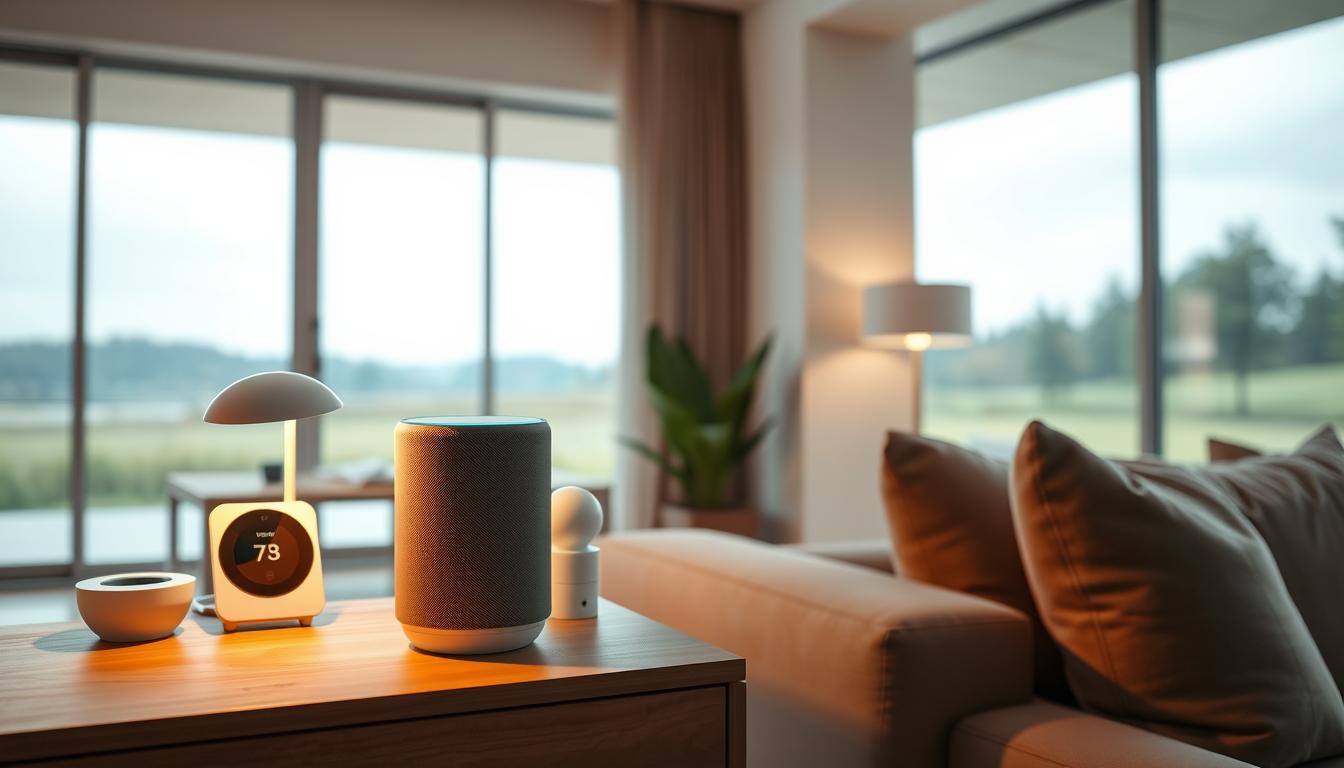The idea of a Smart Home System has been around for years. It was first seen in the Disney movie “Smart House” from the ’90s. Now, it’s a reality and is more affordable than ever.
You can buy a device that adds smart technology to your home for under a month’s Netflix. Building a whole system costs just a few hundred dollars. This makes it easy for anyone to turn their home into a high-tech space.
Now, you can control your home’s lights, temperature, and security with your smartphone. We’ll show you how to set up your first Smart Home System.
Key Takeaways
- Smart Home Systems are now more affordable and accessible.
- You can start with a single device and expand your system.
- Smart technology integrates various aspects of your home.
- Setting up a Smart Home System is easier than you think.
- A Smart Home System can enhance your living experience.
What is a Smart Home System?
Smart home technology is changing how we live. It connects different devices to make our lives better. A smart home system is a network of devices that work together. They make our lives more convenient, secure, and efficient.
Definition and Key Features
A smart home system connects devices like lights, temperature control, security cameras, and entertainment systems. It lets homeowners control and monitor these devices from anywhere. The main features are remote access, device integration, and automated routines.
Devices in a smart home system are controlled through a central hub or voice assistant. This makes everything work together smoothly and is easy to use.
Benefits of Smart Home Technology
Smart home technology has many benefits. For example, it makes life more convenient by letting you control devices from anywhere. You can turn on lights, adjust the temperature, or secure your home easily.
It also helps save energy and improve home security. Smart devices can lower energy use and utility bills. Plus, smart security cameras and door locks add extra security and peace of mind. For more info, visit this page.
Some key benefits of smart home technology are:
- Increased convenience
- Improved energy efficiency
- Enhanced home security
- Automated routines and scenes
- Remote access and monitoring
Planning Your Smart Home Setup
Starting your smart home journey requires careful planning. It’s important to think about several key factors. These will help make your smart home system successful and functional.
Assessing Your Needs and Goals
Before setting up your smart home, understand your needs and goals. Think about how you live and what you want to achieve. Do you want to improve security, save energy, or make life easier? Knowing your priorities helps you choose the right IoT devices and smart home solutions.
For example, if you want better security, consider smart door locks and cameras. If saving energy is your goal, smart thermostats and lights are a good choice. Tailor your plan to meet your specific needs.
Budgeting for Your Smart Home System
After knowing your needs, set a budget for your smart home. The cost of smart home solutions varies. Make sure your budget matches your goals and priorities.
Start by looking at the costs of devices and systems you want. Don’t forget installation costs if you need a professional. For more help, check out Wired’s guide on setting up a smart home.
Choosing Compatible Devices
Choosing devices that work well together is key. With many brands and technologies, finding compatible ones can be hard. Look for devices that use common protocols like Zigbee or Z-Wave. Or choose ones certified for Apple HomeKit, Google Assistant, or Amazon Alexa.
By picking compatible devices, your smart home will work smoothly. You’ll be able to control everything from one place. This makes your smart home easier to use and more functional.
Selecting Your Smart Home Hub
The smart home hub is key to your automated living system. It connects various smart devices, making your home more secure and smart. A good hub ensures all devices work well together.
Choosing the right smart home hub is important. It’s the brain of your smart home, controlling and connecting devices. For more info, visit https://www.adt.com/resources/choosing-smart-hubs.
Popular Smart Home Hubs in the Market
Here are some top smart home hubs:
- SmartThings Hub by Samsung
- Amazon Echo with Alexa
- Google Home with Google Assistant
- Apple HomePod with Siri
- Wink Hub
Each hub has its own features, compatibility, and price. For example, the SmartThings Hub works with many devices. The Amazon Echo is great for voice commands.
Considerations for Choosing a Hub
Think about these when picking a hub:
- Device Compatibility: Make sure the hub works with your devices.
- Ease of Use: Pick a hub with an easy app and interface.
- Security: Choose a hub that focuses on security.
- Scalability: Find a hub that grows with your smart home.
By considering these points, you can pick a hub that makes your home smart and secure.

Installation and Configuration
Setting up your smart home devices is key for a smooth experience. A well-installed system boosts your home’s functionality. It also makes sure all devices work well together.
DIY Installation vs. Professional Help
Choosing between DIY or professional installation is your main decision. DIY installation saves money and lets you learn about your system. But, it needs tech skills and takes time. Professional installation gives you peace of mind and correct setup, but costs more.
To start your smart home hub, just follow the maker’s guide. Most systems are easy to use, so you can do it yourself. Yet, if you’re unsure, getting help from a pro is an option. For more on smart tech, check out Quirk Nerd’s article on smart tech.
Step-by-Step Setup Guide
Here’s a simple guide to set up your Smart Home System:
- Unbox and install your devices as the maker says.
- Get and install the needed apps on your phone or tablet.
- Use the app to link your devices to the hub.
- Set up your devices and any routines or automations.
- Check your system to make sure everything works right.
Connecting Devices and Apps
Linking your devices and apps is a big part of setup. Make sure all devices work with your Smart Home System and pair them as the maker suggests. Most systems use one app to control everything, making it simple to manage your home.
By following these steps and deciding on DIY or pro installation, you can have a fully working Smart Home System. It will make your home better.
Tips for Optimizing Your Smart Home Experience
To get the most out of your home automation system, create routines and automations. This makes your life simpler. It also helps lower your energy bills and improves your smart technology experience.
Security and Privacy
Keeping your smart home system secure and private is key. Regular software updates are crucial to avoid security risks. This simple step keeps your system safe and your smart devices working well.
Streamlining with Routines
Creating routines and automations changes your daily life for the better. For example, automating lights and thermostats cuts down energy use. This saves money and makes your life more convenient and efficient.
Maintenance and Upgrades
Regular maintenance and upgrades keep your smart home system in top shape. Staying current with the latest software and features ensures you keep enjoying home automation and smart technology benefits.
FAQ
What is a Smart Home System?
A Smart Home System connects devices to make your home better. It includes things like thermostats, lights, and security cameras. This creates a smart home experience.
What are the benefits of a Smart Home System?
A Smart Home System makes life easier, saves energy, and keeps your home safe. You can control devices from anywhere. It also sends alerts to keep you updated.
How do I plan my Smart Home Setup?
To plan your smart home, first think about what you need. Set a budget and pick devices that work well together. Think about how you want to control them and what features are important.
What is a smart home hub, and why do I need one?
A smart home hub connects and controls your devices. It lets you manage everything from your phone or tablet. It’s key for a seamless smart home experience.
Can I install a Smart Home System myself, or do I need professional help?
You can install a Smart Home System yourself if you’re tech-savvy. But, if you’re not, a pro can do it right. They ensure it’s set up just for you.
How do I ensure the security and privacy of my Smart Home System?
To keep your Smart Home System safe, use strong passwords. Update your devices regularly. Only let trusted people access it. Use encryption to protect your data.
Can I expand or upgrade my Smart Home System later?
Yes, most Smart Home Systems can grow and change. You can add new devices or features. Keeping it updated ensures it stays useful for you.
What are some popular smart home devices that I can integrate into my system?
Popular devices include smart thermostats, lights, and cameras. You can also add smart door locks and speakers. These enhance your smart home.
How can I create routines and automations in my Smart Home System?
To set up routines, use your hub or app. Create scenes and schedules. For example, a “good morning” routine can open curtains and start coffee. Automate tasks like turning off lights when you leave.





